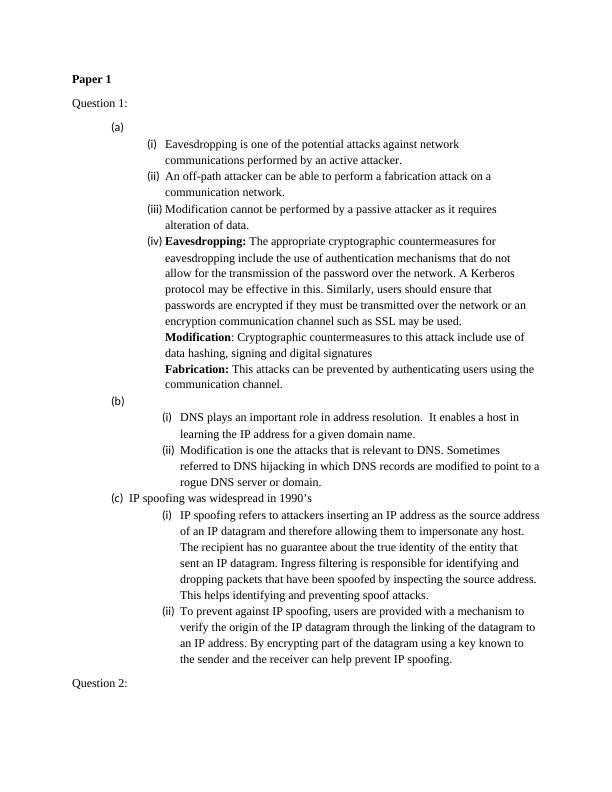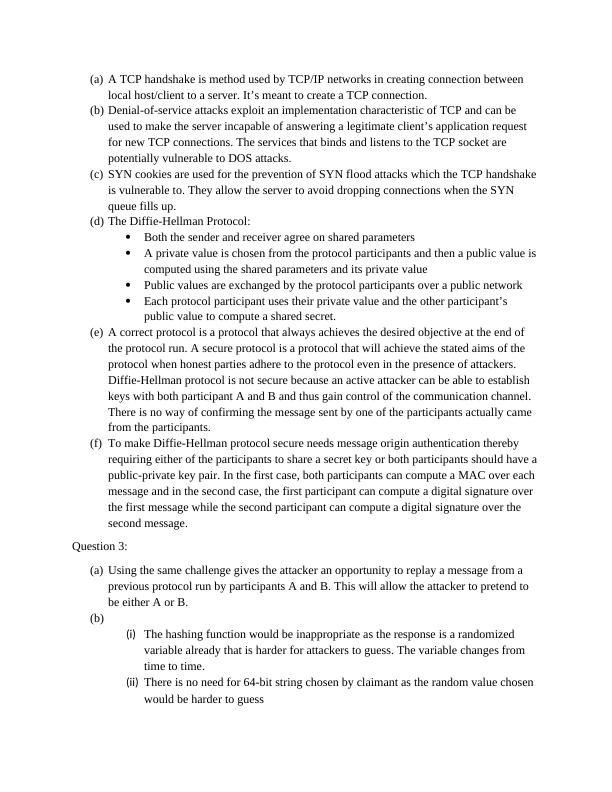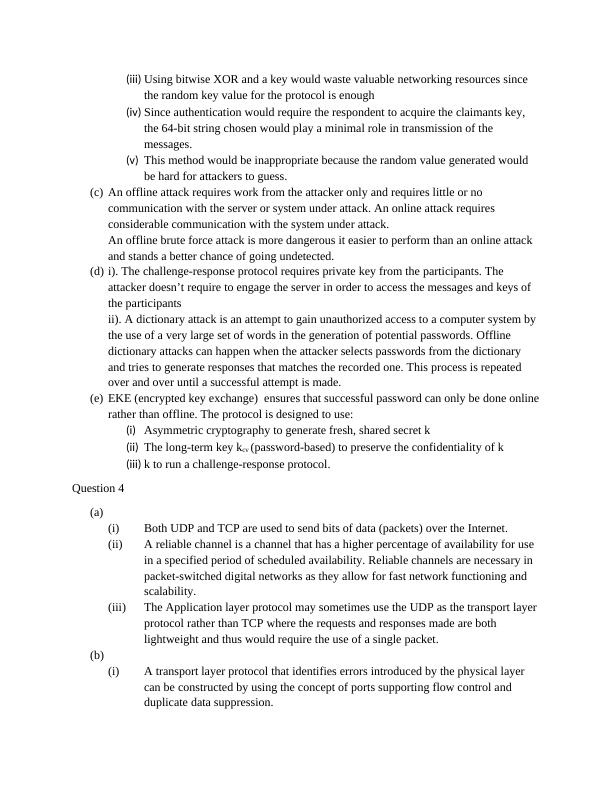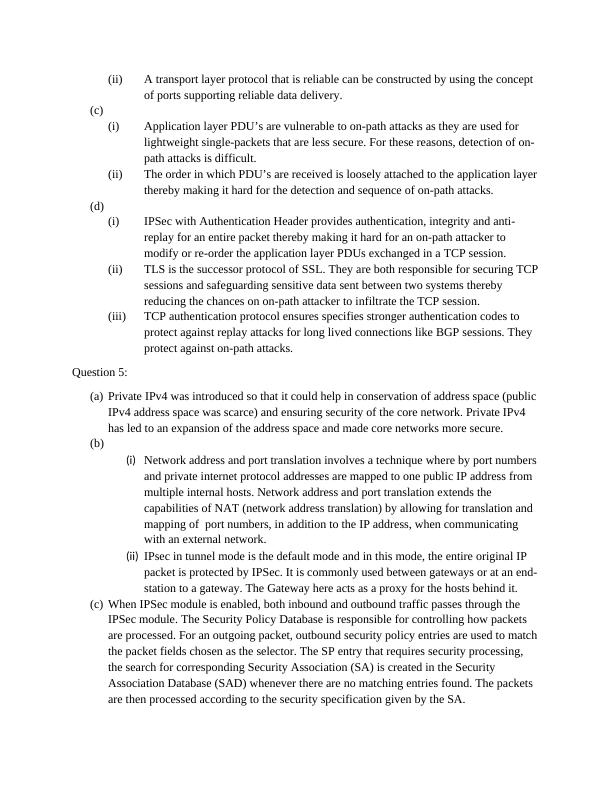Network Security and Protocols
Introduction to IY5511 Network Security course at Royal Holloway, University of London, covering the evolution of the Internet and mobile technology, potential network attacks, and the role of DNS in today's Internet.
12 Pages4857 Words176 Views
Added on 2023-06-12
About This Document
This content covers various network security attacks such as eavesdropping, modification, fabrication, IP spoofing, and more. It also explains cryptographic countermeasures, TCP handshake, Diffie-Hellman protocol, IPSec, DNS query-response protocol, and more. The subject is Network Security and Protocols, and the course code is not mentioned. The content is suitable for students pursuing computer science or information technology courses in any college or university.
Network Security and Protocols
Introduction to IY5511 Network Security course at Royal Holloway, University of London, covering the evolution of the Internet and mobile technology, potential network attacks, and the role of DNS in today's Internet.
Added on 2023-06-12
ShareRelated Documents
Paper 1
Question 1:
(a)
(i) Eavesdropping is one of the potential attacks against network
communications performed by an active attacker.
(ii) An off-path attacker can be able to perform a fabrication attack on a
communication network.
(iii) Modification cannot be performed by a passive attacker as it requires
alteration of data.
(iv) Eavesdropping: The appropriate cryptographic countermeasures for
eavesdropping include the use of authentication mechanisms that do not
allow for the transmission of the password over the network. A Kerberos
protocol may be effective in this. Similarly, users should ensure that
passwords are encrypted if they must be transmitted over the network or an
encryption communication channel such as SSL may be used.
Modification: Cryptographic countermeasures to this attack include use of
data hashing, signing and digital signatures
Fabrication: This attacks can be prevented by authenticating users using the
communication channel.
(b)
(i) DNS plays an important role in address resolution. It enables a host in
learning the IP address for a given domain name.
(ii) Modification is one the attacks that is relevant to DNS. Sometimes
referred to DNS hijacking in which DNS records are modified to point to a
rogue DNS server or domain.
(c) IP spoofing was widespread in 1990’s
(i) IP spoofing refers to attackers inserting an IP address as the source address
of an IP datagram and therefore allowing them to impersonate any host.
The recipient has no guarantee about the true identity of the entity that
sent an IP datagram. Ingress filtering is responsible for identifying and
dropping packets that have been spoofed by inspecting the source address.
This helps identifying and preventing spoof attacks.
(ii) To prevent against IP spoofing, users are provided with a mechanism to
verify the origin of the IP datagram through the linking of the datagram to
an IP address. By encrypting part of the datagram using a key known to
the sender and the receiver can help prevent IP spoofing.
Question 2:
Question 1:
(a)
(i) Eavesdropping is one of the potential attacks against network
communications performed by an active attacker.
(ii) An off-path attacker can be able to perform a fabrication attack on a
communication network.
(iii) Modification cannot be performed by a passive attacker as it requires
alteration of data.
(iv) Eavesdropping: The appropriate cryptographic countermeasures for
eavesdropping include the use of authentication mechanisms that do not
allow for the transmission of the password over the network. A Kerberos
protocol may be effective in this. Similarly, users should ensure that
passwords are encrypted if they must be transmitted over the network or an
encryption communication channel such as SSL may be used.
Modification: Cryptographic countermeasures to this attack include use of
data hashing, signing and digital signatures
Fabrication: This attacks can be prevented by authenticating users using the
communication channel.
(b)
(i) DNS plays an important role in address resolution. It enables a host in
learning the IP address for a given domain name.
(ii) Modification is one the attacks that is relevant to DNS. Sometimes
referred to DNS hijacking in which DNS records are modified to point to a
rogue DNS server or domain.
(c) IP spoofing was widespread in 1990’s
(i) IP spoofing refers to attackers inserting an IP address as the source address
of an IP datagram and therefore allowing them to impersonate any host.
The recipient has no guarantee about the true identity of the entity that
sent an IP datagram. Ingress filtering is responsible for identifying and
dropping packets that have been spoofed by inspecting the source address.
This helps identifying and preventing spoof attacks.
(ii) To prevent against IP spoofing, users are provided with a mechanism to
verify the origin of the IP datagram through the linking of the datagram to
an IP address. By encrypting part of the datagram using a key known to
the sender and the receiver can help prevent IP spoofing.
Question 2:

(a) A TCP handshake is method used by TCP/IP networks in creating connection between
local host/client to a server. It’s meant to create a TCP connection.
(b) Denial-of-service attacks exploit an implementation characteristic of TCP and can be
used to make the server incapable of answering a legitimate client’s application request
for new TCP connections. The services that binds and listens to the TCP socket are
potentially vulnerable to DOS attacks.
(c) SYN cookies are used for the prevention of SYN flood attacks which the TCP handshake
is vulnerable to. They allow the server to avoid dropping connections when the SYN
queue fills up.
(d) The Diffie-Hellman Protocol:
Both the sender and receiver agree on shared parameters
A private value is chosen from the protocol participants and then a public value is
computed using the shared parameters and its private value
Public values are exchanged by the protocol participants over a public network
Each protocol participant uses their private value and the other participant’s
public value to compute a shared secret.
(e) A correct protocol is a protocol that always achieves the desired objective at the end of
the protocol run. A secure protocol is a protocol that will achieve the stated aims of the
protocol when honest parties adhere to the protocol even in the presence of attackers.
Diffie-Hellman protocol is not secure because an active attacker can be able to establish
keys with both participant A and B and thus gain control of the communication channel.
There is no way of confirming the message sent by one of the participants actually came
from the participants.
(f) To make Diffie-Hellman protocol secure needs message origin authentication thereby
requiring either of the participants to share a secret key or both participants should have a
public-private key pair. In the first case, both participants can compute a MAC over each
message and in the second case, the first participant can compute a digital signature over
the first message while the second participant can compute a digital signature over the
second message.
Question 3:
(a) Using the same challenge gives the attacker an opportunity to replay a message from a
previous protocol run by participants A and B. This will allow the attacker to pretend to
be either A or B.
(b)
(i) The hashing function would be inappropriate as the response is a randomized
variable already that is harder for attackers to guess. The variable changes from
time to time.
(ii) There is no need for 64-bit string chosen by claimant as the random value chosen
would be harder to guess
local host/client to a server. It’s meant to create a TCP connection.
(b) Denial-of-service attacks exploit an implementation characteristic of TCP and can be
used to make the server incapable of answering a legitimate client’s application request
for new TCP connections. The services that binds and listens to the TCP socket are
potentially vulnerable to DOS attacks.
(c) SYN cookies are used for the prevention of SYN flood attacks which the TCP handshake
is vulnerable to. They allow the server to avoid dropping connections when the SYN
queue fills up.
(d) The Diffie-Hellman Protocol:
Both the sender and receiver agree on shared parameters
A private value is chosen from the protocol participants and then a public value is
computed using the shared parameters and its private value
Public values are exchanged by the protocol participants over a public network
Each protocol participant uses their private value and the other participant’s
public value to compute a shared secret.
(e) A correct protocol is a protocol that always achieves the desired objective at the end of
the protocol run. A secure protocol is a protocol that will achieve the stated aims of the
protocol when honest parties adhere to the protocol even in the presence of attackers.
Diffie-Hellman protocol is not secure because an active attacker can be able to establish
keys with both participant A and B and thus gain control of the communication channel.
There is no way of confirming the message sent by one of the participants actually came
from the participants.
(f) To make Diffie-Hellman protocol secure needs message origin authentication thereby
requiring either of the participants to share a secret key or both participants should have a
public-private key pair. In the first case, both participants can compute a MAC over each
message and in the second case, the first participant can compute a digital signature over
the first message while the second participant can compute a digital signature over the
second message.
Question 3:
(a) Using the same challenge gives the attacker an opportunity to replay a message from a
previous protocol run by participants A and B. This will allow the attacker to pretend to
be either A or B.
(b)
(i) The hashing function would be inappropriate as the response is a randomized
variable already that is harder for attackers to guess. The variable changes from
time to time.
(ii) There is no need for 64-bit string chosen by claimant as the random value chosen
would be harder to guess

(iii) Using bitwise XOR and a key would waste valuable networking resources since
the random key value for the protocol is enough
(iv) Since authentication would require the respondent to acquire the claimants key,
the 64-bit string chosen would play a minimal role in transmission of the
messages.
(v) This method would be inappropriate because the random value generated would
be hard for attackers to guess.
(c) An offline attack requires work from the attacker only and requires little or no
communication with the server or system under attack. An online attack requires
considerable communication with the system under attack.
An offline brute force attack is more dangerous it easier to perform than an online attack
and stands a better chance of going undetected.
(d) i). The challenge-response protocol requires private key from the participants. The
attacker doesn’t require to engage the server in order to access the messages and keys of
the participants
ii). A dictionary attack is an attempt to gain unauthorized access to a computer system by
the use of a very large set of words in the generation of potential passwords. Offline
dictionary attacks can happen when the attacker selects passwords from the dictionary
and tries to generate responses that matches the recorded one. This process is repeated
over and over until a successful attempt is made.
(e) EKE (encrypted key exchange) ensures that successful password can only be done online
rather than offline. The protocol is designed to use:
(i) Asymmetric cryptography to generate fresh, shared secret k
(ii) The long-term key kcv (password-based) to preserve the confidentiality of k
(iii) k to run a challenge-response protocol.
Question 4
(a)
(i) Both UDP and TCP are used to send bits of data (packets) over the Internet.
(ii) A reliable channel is a channel that has a higher percentage of availability for use
in a specified period of scheduled availability. Reliable channels are necessary in
packet-switched digital networks as they allow for fast network functioning and
scalability.
(iii) The Application layer protocol may sometimes use the UDP as the transport layer
protocol rather than TCP where the requests and responses made are both
lightweight and thus would require the use of a single packet.
(b)
(i) A transport layer protocol that identifies errors introduced by the physical layer
can be constructed by using the concept of ports supporting flow control and
duplicate data suppression.
the random key value for the protocol is enough
(iv) Since authentication would require the respondent to acquire the claimants key,
the 64-bit string chosen would play a minimal role in transmission of the
messages.
(v) This method would be inappropriate because the random value generated would
be hard for attackers to guess.
(c) An offline attack requires work from the attacker only and requires little or no
communication with the server or system under attack. An online attack requires
considerable communication with the system under attack.
An offline brute force attack is more dangerous it easier to perform than an online attack
and stands a better chance of going undetected.
(d) i). The challenge-response protocol requires private key from the participants. The
attacker doesn’t require to engage the server in order to access the messages and keys of
the participants
ii). A dictionary attack is an attempt to gain unauthorized access to a computer system by
the use of a very large set of words in the generation of potential passwords. Offline
dictionary attacks can happen when the attacker selects passwords from the dictionary
and tries to generate responses that matches the recorded one. This process is repeated
over and over until a successful attempt is made.
(e) EKE (encrypted key exchange) ensures that successful password can only be done online
rather than offline. The protocol is designed to use:
(i) Asymmetric cryptography to generate fresh, shared secret k
(ii) The long-term key kcv (password-based) to preserve the confidentiality of k
(iii) k to run a challenge-response protocol.
Question 4
(a)
(i) Both UDP and TCP are used to send bits of data (packets) over the Internet.
(ii) A reliable channel is a channel that has a higher percentage of availability for use
in a specified period of scheduled availability. Reliable channels are necessary in
packet-switched digital networks as they allow for fast network functioning and
scalability.
(iii) The Application layer protocol may sometimes use the UDP as the transport layer
protocol rather than TCP where the requests and responses made are both
lightweight and thus would require the use of a single packet.
(b)
(i) A transport layer protocol that identifies errors introduced by the physical layer
can be constructed by using the concept of ports supporting flow control and
duplicate data suppression.

(ii) A transport layer protocol that is reliable can be constructed by using the concept
of ports supporting reliable data delivery.
(c)
(i) Application layer PDU’s are vulnerable to on-path attacks as they are used for
lightweight single-packets that are less secure. For these reasons, detection of on-
path attacks is difficult.
(ii) The order in which PDU’s are received is loosely attached to the application layer
thereby making it hard for the detection and sequence of on-path attacks.
(d)
(i) IPSec with Authentication Header provides authentication, integrity and anti-
replay for an entire packet thereby making it hard for an on-path attacker to
modify or re-order the application layer PDUs exchanged in a TCP session.
(ii) TLS is the successor protocol of SSL. They are both responsible for securing TCP
sessions and safeguarding sensitive data sent between two systems thereby
reducing the chances on on-path attacker to infiltrate the TCP session.
(iii) TCP authentication protocol ensures specifies stronger authentication codes to
protect against replay attacks for long lived connections like BGP sessions. They
protect against on-path attacks.
Question 5:
(a) Private IPv4 was introduced so that it could help in conservation of address space (public
IPv4 address space was scarce) and ensuring security of the core network. Private IPv4
has led to an expansion of the address space and made core networks more secure.
(b)
(i) Network address and port translation involves a technique where by port numbers
and private internet protocol addresses are mapped to one public IP address from
multiple internal hosts. Network address and port translation extends the
capabilities of NAT (network address translation) by allowing for translation and
mapping of port numbers, in addition to the IP address, when communicating
with an external network.
(ii) IPsec in tunnel mode is the default mode and in this mode, the entire original IP
packet is protected by IPSec. It is commonly used between gateways or at an end-
station to a gateway. The Gateway here acts as a proxy for the hosts behind it.
(c) When IPSec module is enabled, both inbound and outbound traffic passes through the
IPSec module. The Security Policy Database is responsible for controlling how packets
are processed. For an outgoing packet, outbound security policy entries are used to match
the packet fields chosen as the selector. The SP entry that requires security processing,
the search for corresponding Security Association (SA) is created in the Security
Association Database (SAD) whenever there are no matching entries found. The packets
are then processed according to the security specification given by the SA.
of ports supporting reliable data delivery.
(c)
(i) Application layer PDU’s are vulnerable to on-path attacks as they are used for
lightweight single-packets that are less secure. For these reasons, detection of on-
path attacks is difficult.
(ii) The order in which PDU’s are received is loosely attached to the application layer
thereby making it hard for the detection and sequence of on-path attacks.
(d)
(i) IPSec with Authentication Header provides authentication, integrity and anti-
replay for an entire packet thereby making it hard for an on-path attacker to
modify or re-order the application layer PDUs exchanged in a TCP session.
(ii) TLS is the successor protocol of SSL. They are both responsible for securing TCP
sessions and safeguarding sensitive data sent between two systems thereby
reducing the chances on on-path attacker to infiltrate the TCP session.
(iii) TCP authentication protocol ensures specifies stronger authentication codes to
protect against replay attacks for long lived connections like BGP sessions. They
protect against on-path attacks.
Question 5:
(a) Private IPv4 was introduced so that it could help in conservation of address space (public
IPv4 address space was scarce) and ensuring security of the core network. Private IPv4
has led to an expansion of the address space and made core networks more secure.
(b)
(i) Network address and port translation involves a technique where by port numbers
and private internet protocol addresses are mapped to one public IP address from
multiple internal hosts. Network address and port translation extends the
capabilities of NAT (network address translation) by allowing for translation and
mapping of port numbers, in addition to the IP address, when communicating
with an external network.
(ii) IPsec in tunnel mode is the default mode and in this mode, the entire original IP
packet is protected by IPSec. It is commonly used between gateways or at an end-
station to a gateway. The Gateway here acts as a proxy for the hosts behind it.
(c) When IPSec module is enabled, both inbound and outbound traffic passes through the
IPSec module. The Security Policy Database is responsible for controlling how packets
are processed. For an outgoing packet, outbound security policy entries are used to match
the packet fields chosen as the selector. The SP entry that requires security processing,
the search for corresponding Security Association (SA) is created in the Security
Association Database (SAD) whenever there are no matching entries found. The packets
are then processed according to the security specification given by the SA.

End of preview
Want to access all the pages? Upload your documents or become a member.
Related Documents
Introduction to Information Assurance and Information Security Assignment 2022lg...
|4
|529
|16
Network Security Executive Summary 2022lg...
|10
|2381
|9
Introduction to Networks and Internetworkslg...
|25
|7002
|65
ICT Ethical Hacking: DNS and DHCP Attacks and Preventionlg...
|33
|3485
|255
CSI2102 - Information Security: Assignmentlg...
|17
|1220
|277
Manipulation of the Handshake Protocollg...
|3
|1367
|380
